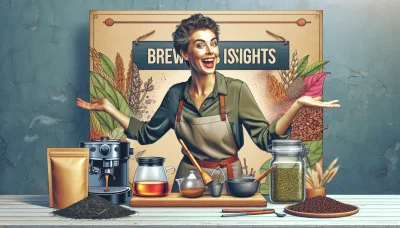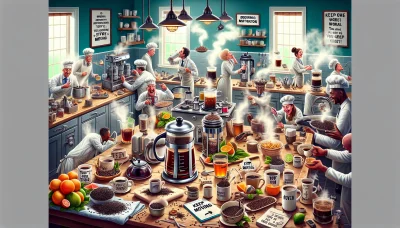Flavorful Brewing with The Coffee Bean Quiz
Test Your Knowledge
Question of
Flavorful Brewing with The Coffee Bean
Flavorful Brewing with The Coffee Bean refers to the art and science of extracting the rich, complex flavors inherent in coffee beans through various brewing methods. This concept emphasizes the importance of the coffee bean's origin, variety, and roast level, as well as the brewing technique, to achieve a cup of coffee that is not only aromatic and tasty but also highlights the unique characteristics of the bean. Whether it's through espresso, French press, pour-over, or any other method, the goal is to bring out the best possible flavor profile from the beans. This approach to coffee brewing is akin to the meticulous process of brewing tea, where the focus is also on the quality of the leaves and the brewing method to produce a drink that is both enjoyable and reflective of its origin.
The Art of Selecting Coffee Beans
Choosing the right coffee beans is crucial for achieving a cup of coffee that is rich in flavor and aroma. The process begins with understanding the various types of beans available, including Arabica and Robusta, each offering distinct taste profiles. Arabica beans are known for their smooth, complex flavor notes, while Robusta beans are more robust and stronger in taste. When selecting beans, consider the roast level, as this significantly impacts the taste. Light roasts retain more of the bean's original flavor, highlighting its unique characteristics, while dark roasts offer a bolder, more intense flavor. Additionally, the origin of the beans plays a role in the flavor profile, with beans from different regions offering notes ranging from fruity to nutty. Opt for single-origin beans if you're interested in experiencing the unique flavors of a specific region. Always check the roast date to ensure freshness, as coffee beans are best used within a month of roasting for optimal flavor. Lastly, experimenting with different beans and roasting styles can help you discover your personal preference, enhancing your coffee brewing experience. Similar principles apply to selecting tea leaves, where the origin, type, and freshness determine the quality of the brew.
Understanding Coffee Roasts
The world of coffee is rich and varied, with the roast level of the beans playing a pivotal role in shaping the final cup's flavor profile. Coffee roasts are generally categorized into four main types: light, medium, medium-dark, and dark. Light roasts are characterized by a light brown color and a lack of oil on the surface of the beans. They often have a higher acidity and retain the original flavors of the coffee bean, which can range from fruity to floral. Medium roasts, with their medium brown color, offer a more balanced flavor, aroma, and acidity. This roast is often preferred for its well-rounded taste profile. Moving towards the darker end of the spectrum, medium-dark roasts have a richer, darker color with some oil on the surface. They begin to exhibit a bittersweet aftertaste that many coffee lovers cherish. Finally, dark roasts boast a shiny black bean with an oily surface and a pronounced bitterness. The original flavors of the bean are mostly overshadowed by the flavors from the roasting process. Each roast type offers a unique experience, catering to a wide range of palates and preferences. Whether you're brewing a delicate light roast to enjoy its intricate flavors or a robust dark roast for a powerful flavor punch, understanding these roasts can enhance your coffee brewing and tasting experience.
The Brewing Process
Brewing coffee is an art that requires attention to detail to extract the maximum flavor from your coffee beans. The process begins with selecting high-quality, freshly roasted beans. Grind your beans to the right size just before brewing; a medium grind is often best for a balanced extraction. The water temperature is crucial - aim for 195°F to 205°F, as too hot water can extract bitter compounds, while too cool water won't extract enough flavor. The coffee-to-water ratio is also key; a general guideline is 1 to 2 tablespoons of coffee for every 6 ounces of water, but adjust to taste. For brewing, there are several methods, including drip coffee, French press, espresso, and pour-over, each offering a unique flavor profile and texture. Finally, ensure your brewing equipment is clean to avoid off-flavors. Experiment with these variables to find your perfect cup of coffee.
Brewing Methods for Flavorful Coffee
- French Press
- Pour Over
- Cold Brew
- Espresso
Choosing the Right Equipment
| Equipment | Features | Pros | Cons |
|---|---|---|---|
| French Press | Manual brewing method, steeping coffee grounds in hot water | Rich, full-bodied flavor; simple to use; affordable | Can be gritty if grounds escape; requires coarse grind |
| Espresso Machine | Forces hot water through finely-ground coffee under pressure | Strong, concentrated coffee; versatile for various drinks | Expensive; steep learning curve |
| Pour Over | Manual method where hot water is poured over coffee grounds | Control over brewing time and temperature; clean taste | Requires technique and patience; equipment varies |
| AeroPress | Pressurized brewing method, combining features of espresso and French press | Quick brewing time; smooth, rich coffee; portable | Small batch size; requires filters |
| Drip Coffee Maker | Automated brewing, dripping hot water over coffee grounds | Convenient; brews multiple cups; programmable options | Less control over brewing variables; quality varies by model |
Maintaining Your Coffee Equipment
To ensure your coffee brewing equipment delivers the optimal flavor, regular cleaning and maintenance are crucial. Start by descaling your coffee maker every month to remove mineral buildup, using a mix of equal parts water and white vinegar. Run this solution through the machine, followed by a few cycles of plain water to rinse any remaining vinegar. For espresso machines, clean the portafilter and steam wand after each use, and backflush with water weekly. Don’t forget about your grinder; remove coffee oils and particles by running a handful of uncooked white rice through it once a month. Finally, wash all removable parts and accessories with warm, soapy water regularly. Following these steps will not only improve your coffee's taste but also extend the life of your brewing equipment.
Conclusion: The Joy of Flavorful Brewing
Understanding the nuances of coffee beans, the impact of different roasts, the intricacies of various brewing methods, and the critical importance of equipment maintenance is essential for anyone looking to master the art of coffee brewing. Each element plays a significant role in the final taste of your coffee, influencing its body, acidity, and overall flavor profile. Whether you're a seasoned barista or a home brewing enthusiast, deepening your knowledge in these areas can lead to more enjoyable, rich, and satisfying coffee experiences. The same principles apply to tea brewing, where the choice of leaves, water temperature, and steeping time can dramatically alter the flavor. By valuing these components, brewing becomes not just a daily routine but a joyful exploration of flavors and aromas, bringing the world of coffee and tea into your cup.












